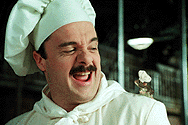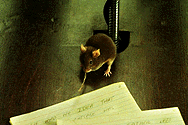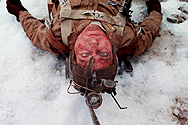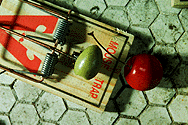
Directed by Gore Verbinski
Visual Effects Supervisor: Charles Gibson

Directed by Gore Verbinski
Visual Effects Supervisor: Charles Gibson
BLUE SKY|VIFX
PACIFIC TITLE DIGITAL
ANIMAL LOGIC FILM
PARAMAECIUM
Motion Control Provided by: IMAGE G
Animatronics and Creature Effects: STAN WINSTON STUDIOS
Special Effects Supervisor: MICHAEL LANTIERI
 Visual Effects Produced by:
Visual Effects Produced by:
RHYTHM & HUES STUDIOS
Animation Supervisor: Sylvia Wong
VFX Producer: Shannon Casey
Full R&H Credits
CG Supervisor: Derek Spears
Compositing Supervisor: David Sosalla
Visual Effects Supervisor: Chris Godfrey
Review by Todd Vaziri
The most intelligent mouse modern cinema has ever seen is the star of MOUSEHUNT, a visual effects-filled family movie, with the film illusions supervised by Academy Award winner Charles Gibson (BABE). To depict the fearless and crafty mouse, filmmakers used a combination of footage taken from a real, trained mouse, an
Several of the CG mouse shots are undetectable. Unlike dinosaurs, an eighty-year-old ocean liner, or a nasty one ton brain bug, everybody knows what a mouse looks like and how it moves. Not only do the laws of physics and mechanics need to be adhered, but the common appearance of the common mouse needed to be perfectly produced, and animated. While CG has convincingly created fantasy, nightmarish creatures with an amount of 'believablilty', no CG representation of a common animal has ever been as successful, nor used so extensively, than in MOUSEHUNT. Rhythm & Hues produced 20 shots containing the CG mouse.
The common cues that expose a CG creature's presence--dull or no camera movement, uneven lighting of the CG character, poor fur representation, awkward contrast levels, or goofy movement--are not visible in the majority of Rhythm & Hues' shots. In nearly all of the CG shots, the camera moves freely, matching the frenetic and
Entire sequences use the real mouse, an animatronic mouse, and the CG mouse interchangeably, and all the techniques flow together to produce seamless sequences without the distraction of obvious visual effects.
There are plenty of terrific, memorable CG mouse shots (if you can spot them). The absolute finest, in my opinion, are a series of shots where the mouse climbs onto the auction podium, near the end of the movie. It's not jumping, climbing, or evading anything. It's just sitting there, knawing on a piece of string--the CG mouse is indistinguishable from a real mouse. The twiches, the highlights, the movement are all very realistic. And the mouse is rather large in frame and unobstructed, too, not hidden behind dust or blurred by camera movement.
A wide shot of the two brothers trying to smack the mouse with a broom is another inspired, wonderful shot. The mouse runs all over the kitchen floor, with Nathan Lane smacking his broom all over the floor, with the mouse darting out of the way moments before the impact. It's undoubtedly a CG shot, due to the complicated nature of the mouse's movements, but that fact doesn't really hurt the shot.
Not only did Rhythm & Hues create believable, realistic looking CG mice for the film, but they also produced other CG elements, as well. In one sequence, the mouse launches a cherry into a minefield of mousetraps, all ready to snap. The cherry bounces all over the kitchen floor, narrowly missing the traps at every bounce. It eventually spins and rests beside a trap, only to cause it to snap. The entire sequence was produced with a CG cherry that not only holds up to scrutiny, but moves with realistic grace. The camera pulls in very tight on the cherry, and even as it almost fills the entire screen, it holds up, with the skin accurately reflecting the room's light source.
There are other CG moments in the film, such as the spinning quarter that realistically moves, spins and eventually fills the screen, even under the tricky lighting of a single flashlight. Some of the film's introductory visual effects shots are not up to the caliber of the rest of the film, and appear cartoony--a disgusting cockroach climbs out of a cigar box, and wreaks havoc in Nathan Lane's restaurant. The introductory shot of the cockroach didn't look or move realistically at all. The insect's shadow was hokey, and the movement was quite robotic and cartoonish, as were the closeups of the cockroach parts that are featured later in the scene.
Non-mouse effects that also appear in the film are found in a nice sequence, where the brothers mistakenly ignite gas through the chimney, blowing Nathan Lane hundreds of feet into the air. The initial shots of the brothers being engulfed by flame are really neat--they're realistic without being gory or overly-violent. The smoke trails and explosion elements were nicely comped and fit well into the background plates. Another cool shot occurs as the brothers blow up the bugbomb, burning the floor in a circular pattern, eventually disintegrating it. It's a nice, detailed shot that has a lot of character.
Not easily overlooked is a beautiful transition early in the film. The camera dollys toward a bakery window, where a huge cake with a tiny plastic house on the top is showcased. The frame, complete with the brothers' reflection, slowly dissolves to an exterior nighttime shot of the house where most of the film takes place. It's a lovely shot; patient and simple, and providing a wonderful transition to the next scene.
There are also a series of shots that are quite cartoonish, and that lack the realism of the best of the CG shots. Right after the cat's four limbs break out of the box, it hobbles away as the camera cranes up. While the lighting and matchmoving were exceptional in the shot, the cat's movement is silly and quite fake. Its arms look like stiff rods that rotate in a circular pattern. The cat should never have had to walk like that. Also quite disappointing is the Stan Winston Studio cat, which doesn't look real at all.
There are a few shots, also, of the CG mouse that are recognizable as effects shots. Three of them involve highly complicated moves that, when combined with some not-so-great rendering/compositing, become noticeable. One is the mouse's slide down the banister, and the next shot of it bouncing off the wall, landing on a paint can. The landing is the worst part of the shot, as the mouse looks like it stops on a dime and lands without any recoil. Another shot that suffers from perhaps too much movement is a shot looking straight up as the mouse jumps from a shelf to a light chain, and then to another shelf. The matchmoving is excellent in the shot; however, as the mouse hangs off the last shelf, a close look at it reveals its synthetic nature. The fur seems flat, and the contrast just doesn't seem right.
The film's final CG mouse shot is one of the movie's most challenging effects shots. The ten second shot takes place at the end of the film, with the mouse sitting on Nathan Lane's shoulder, testing out various cheeses. This shot is a fine example of fine execution, with the only distraction being the complicated choreography of the mouse. Within the shot, the mouse picks up cheese, eats it, spits it out, even nods to Lane, right on cue. The tracking, lighting and shadows are top notch throughout the entire shot, which is almost agonizingly long. Even as Lane turns and walks off camera, the mouse truly seems attached to his shoulder.
Of the 160 total effects shots for MOUSEHUNT, only a few are recognizable. There's a terrific couple of sequences where the mouse is running away from danger--one, where he's being chased by an avalanche of nails, and another where he's running from a deluge of water. Both sequences are exciting and seamless, which accurately sums up the visual effects effort for the entire film.
animatronic version created by Stan Winston Studios, and a computer generated version created by Rhythm & Hues Studios.

Rhythm & Hues' CG mouse sits on Nathan Lane's shoulder in this long, long shot.
dynamic camera moves of first unit photography. The lighting of the CG mouse, cheese, fruit, whatever, always seemed naturalistic and real, as if those items actually existed in the background plate's world. The mouse's tiny, short hairs were realistically portrayed, sometimes with a keen little backlight, highlighting only the tips of the hairs. And in only a few cases, the animation was quite realistic and plausible.

The mouse climbs onto the podium in one of the best CG mouse scenes in the film.
Another long, tight, unobstructed shot takes place as Christopher Walken is foiled by the little bugger, and lies flat on his back in the snow. In one long shot, the mouse travels down a wire, walks all over his face, and leaves Walken a little present on his chin. Once again, all the twiches and ticks that we've all seen in real mice are accurately presented.

The CG mouse tramples over Christopher Walken's face.
As the mouse gets away with olives and other food on his back, the real-life, trained mouse was used, while CG food was placed on his back. The best shot of the sequence is a harrowing camera move, with the camera tracking backwards, the mouse running toward the camera, and the brothers stumbling behind the mouse trying to nail it with a vacuum cleaner.

A CG cherry rolls toward the trap in this photorealistic shot.
Rhythm & Hues also fashioned a CG box to represent the box that houses a nasty cat. The cat causes the box to bounce up and down on the ground, finally with the cat's four paws blasting out of the sides of the box. These shots are extraordinary, and truly appear as if they were live-action special effects.

The box containing Catzilla was actually a CGI model, built, animated and rendered by Rhythm & Hues.
Check out Cinefex 73.
Official Web Site: http://www.freezone.com/mousehunt
Rhythm & Hues' MOUSEHUNT Page: http://www.rhythm.com/mouse

. . VFX HQ Produced by Todd Vaziri . . http://www.vfxhq.com . . e-mail: tvaziri@gmail.com . .
All text Copyright © 1998 Todd Vaziri, unless otherwise noted